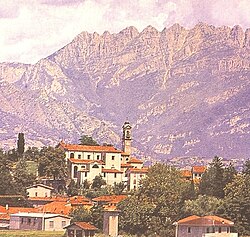Molteno
| Molteno | |
|---|---|
| Comune | |
| Comune di Molteno | |
 |
|
| Location of Molteno in Italy | |
| Coordinates: 45°47′N 9°18′E / 45.783°N 9.300°ECoordinates: 45°47′N 9°18′E / 45.783°N 9.300°E | |
| Country | Italy |
| Region | Lombardy |
| Province / Metropolitan city | Lecco (LC) |
| Frazioni | Gaesso, Molino, Luzzana, Raviola, Pascolo, Coroldo |
| Area | |
| • Total | 3.2 km2 (1.2 sq mi) |
| Population (December 2004) | |
| • Total | 3,206 |
| • Density | 1,000/km2 (2,600/sq mi) |
| Demonym(s) | Moltenesi |
| Time zone | CET (UTC+1) |
| • Summer (DST) | CEST (UTC+2) |
| Postal code | 22047 |
| Dialing code | 031 |
| Patron saint | San Rocco |
| Saint day | 23 April |
| Website | Official website |
Molteno ([molˈte no]) is a comune (municipality) and a hill-top town in the Province of Lecco in the Italian region Lombardy, located about 35 kilometres (22 mi) northeast of Milan and about 11 kilometres (7 mi) southwest of Lecco. As of 31 December 2004, it had a population of 3,206 and an area of 3.2 square kilometres (1.2 sq mi).
The central feature of the area is the isolated hill, “Il Ceppo”, on the top of which is the church of San Giorgio (patron saint of the region). The slopes around it are still partly covered in vines and mulberry trees.
The Molteno castle, which commanded the area from this hill in Medieval times, no longer exists.
Molteno is also the meeting point of the two main rivers of the area, the Bevera and the smaller Gandaloglio.
The municipality of Molteno contains the frazioni (subdivisions, mainly villages) Gaesso, Molino, Luzzana, Raviola, Pascolo, and Coroldo.
Molteno borders the following municipalities: Annone di Brianza, Bosisio Parini, Costa Masnaga, Garbagnate Monastero, Oggiono, Rogeno, Sirone.
Molteno was a Roman settlement, however it is not known by what name the settlement was called, nor whether the origins of the name "Molteno" stretch back that far. Nonetheless, numerous weapons, ceramics, tools, iron-ware, coins and even tombs have been found here from that period.
The area remained pagan relatively late. Christianity spread in the surrounding countryside from the end of the 5th century, and the first churches were built in the town only around the 6th century. After the collapse of the empire, the region fell into warring tribes which allied with the principal barbarian leaders, such as Uraias the Ostrogoth, who laid waste to Milan in 539. In 568 the Lombards entered northern Italy, giving the region its future name of Lombardy.
...
Wikipedia

